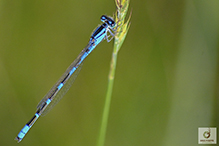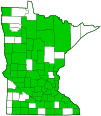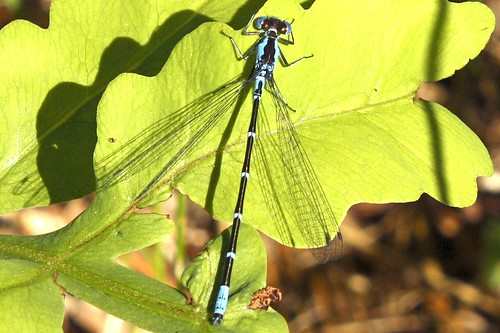tule bluet
(Enallagma carunculatum)
Conservation • Description • Habitat • Ecology • Distribution • Taxonomy
Conservation Status |
|
|||||||
| IUCN Red List | LC - Least Concern |
|||||||
| NatureServe | N5 - Secure SNR - Unranked |
|||||||
| Minnesota | not listed |
|||||||
Description |
||
Tule bluet is a very common and widespread narrow-winged damselfly. It occurs across southern Canada, in most of the United States, and in northern Mexico. In the U.S. it is absent from the southeast and mostly absent from the south-central states. It is common in Minnesota. Larvae live in aquatic vegetation. Adults are found from mid-June to mid-September at lakes, ponds, slow streams, and rivers, whether open or marshy. They are especially prevalent at open shores of large lakes near hardstem bullrush, also called hardstem tule. This is the feature that gives the species its common name. Tule bluet is a small damselfly but a medium-sized bluet. Adults are 1 1⁄16″ to 1 7⁄16″ (27 to 37 mm) in length. Identification of the male is easy when examining the terminal appendages of the abdomen under a microscope. It is more difficult in the field, but identification from clear photos is usually possible. Identification of a female is always difficult without a microscope. The head of the male is black. The compound eyes are blue. Two blue spots on top of the head, one behind each eye, are small, triangular, and connected by a thin line (occipital bar). The thorax of the male is black above and blue on the sides. On the upper side there is a stripe on each side in the shoulder area (antehumeral stripe) and a very thin line in the middle that looks like it could have been drawn with a needle. The line is sometimes incomplete, sometimes missing. On each side there is a black stripe (humeral stripe) just below the antehumeral stripe. The humeral stripe is about half as wide as the antehumeral stripe and is moderately even in width from front to back. The abdomen is slender and mostly blue. This is the feature that identifies this damselfly as a blue-type bluet. Abdominal segments 2 through 4 are more than half blue. Segments 5, 6, and 7 are increasingly black. Segments 8 and 9 are entirely blue. The wings have a narrow, stalk-like base. They are clear except for a single dark cell (stigma) near the tip. The stigma is short, less than twice as long as wide. The median vein (M) splits into three branches. The third branch (M3) begins slightly behind the notch (nodus). The legs are slender and relatively short. On the female the eyespots are smaller. The pale areas are blue merging into olive-tan. The upper side of the abdomen is mostly black. Segments 8 and 9 are black with a thin blue band on the front margin. |
||
Size |
||
Total length: 1 1⁄16″ to 1 7⁄16″ (27 to 37 mm) |
||
Similar Species |
||
Boreal bluet (Enallagma boreale) has very large eyespots that almost touch the eye. Northern bluet (Enallagma annexum) has very large eyespots that almost touch the eye. |
||
Habitat |
||
Lakes, ponds, slow streams, and rivers, whether open or marshy, and open shores of large lakes near bullrushes. |
||
Ecology |
||
Season |
||
One generation per year: Mid-June to mid-September |
||
Behavior |
||
The wings are held over the abdomen when at rest. |
||
Life Cycle |
||
After mating, the female inserts eggs in the stems of bullrushes while still in tandem with the male. Nymphs overwinter. |
||
Naiad Food |
||
Mosquito larvae, mayfly larvae, and other aquatic insect larvae |
||
Adult Food |
||
Small flying insects, including mayflies, flies, small moths, and mosquitoes |
||
Distribution |
||||
|
||||
| 8/26/2022 | ||||
Occurrence |
||||
|
||||
Taxonomy |
|||
Order |
Odonata (Dragonflies and Damselflies) | ||
Suborder |
Zygoptera (Damselflies) | ||
Superfamily |
Coenagrionoidea | ||
Family |
Coenagrionidae (Narrow-winged Damselflies) | ||
Genus |
Enallagma (Bluets) | ||
Synonyms |
|||
Enallagma optimolocus |
|||
Common Names |
|||
tule bluet |
|||
Glossary
Nodus
On dragonflies and damselflies: the small notch on the lead edge of each wing about halfway between the body and the tip.
Stigma
In plants, the portion of the female part of the flower that is receptive to pollen. In Lepidoptera, an area of specialized scent scales on the forewing of some skippers, hairstreaks, and moths. In other insects, a thickened, dark, or opaque cell on the leading edge of the wing.
Visitor Photos |
|||||
Share your photo of this insect. |
|||||
| This button not working for you? Simply email us at info@MinnesotaSeasons.com. Attach one or more photos and, if you like, a caption. |
|||||
Mike Poeppe |
|||||
 |
|||||
MinnesotaSeasons.com Photos |
|||||
|
|||||

Visitor Videos |
|||
Share your video of this insect. |
|||
| This button not working for you? Simply email us at info@MinnesotaSeasons.com. Attach a video, a YouTube link, or a cloud storage link. |
|||
Other Videos |
|||

Created: 8/26/2022
Last Updated:




